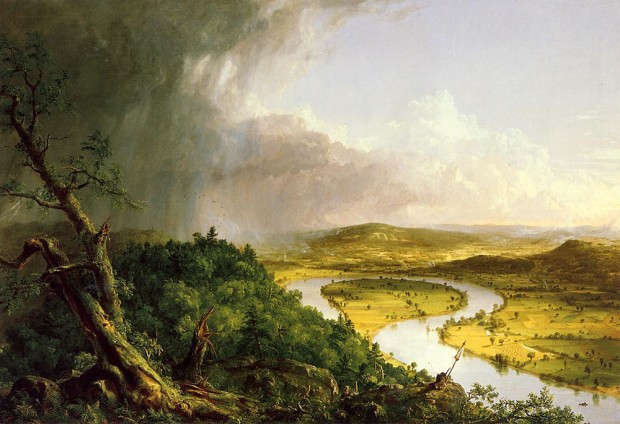5.4- Visual Arts in the Romantic Era
Visual Art Overview [audio:overviewromantic.mp3]
The 19th Century witnessed the development of three major art styles: Romanticism, Realism and Impressionism. Additionally Neoclassicism still held on in the beginning of the century.
Romanticism dominated the first half of the century, but then gradually Realism became the predominant style. The end of the era saw the introduction of a radical new style of art originating in France — Impressionism, which was transformed into Post-Impressionism.
Romanticism [audio:Romantics.mp3]
- Reaction against Neoclassicism
- More Subjective
- Like the Baroque era — artists wanted to elicit emotions and feelings
- Favorite subject matter
- Mists, fantastic, exotic, world of dreams, fabulous landscapes
- Horrible tragedies and injustices were also ideal Romantic subject matter
- Noted as a floating, inexact style, or attitude
- The artist was seen as creator, that reflected God’s power in their genius
Hudson River School [audio:HudsonRiver.mp3]
Be sure to click on the video lecture embedded within the Hudson River School link!
- An American art movement formed in the mid 1800’s
- Landscape painters mostly in New England and upstate New York
- Realistic depictions
- Pastoral settings where nature and man exist peacefully
- Held a reverence for nature as a manifestation of God
- Developed a style called Luminism
[5.3.1 Continue on to learn more about the Romantic artists. Essential information continues..]
Realist Painting
- Developed in the mid 1800’s
- A reaction against Romanticism
- Non-idealized
- Telling the truth as a perfect ideal
- Ordinary subject matter: livestock, farm workers, middle class, ordinary activities
- Absence of theatricality
Pre-Raphaelites [audio:Pre-Raphaelite.mp3]
- An English group of painters set about reforming art
- Their claim was that art prior to the Renaissance — before Raphael, was the only great art.
- Real depictions of models
- Careful attention to details
- Moral subjects
- A second phase of this group focused on subject matter of: Classical Mythology, Bible Stories, Nature
- Click here for a totally optional video hosted by composer Andrew Lloyd Weber.
[5.3.2 Continue on to learn more about the Realist painters]
Impressionism [audio:Impressionismking.mp3]

Claude Monet’s painting, Rue Montorgueil, Paris, Festival of June 30, 1878. Image courtesy of Wikimedia.
Hold on to your hats! The art world is really starting to move and shake.
A style that began in Paris towards the last quarter of the century
The way the painter worked became more important than the content of the painting.
- Depicting a fleeting moment, an impression
- Characterized by sketchy lines, loose brush strokes, dabs of color that blend together
- Favorite subject matter:
- The transitory effects of light and weather
- The amusements and pastimes of the middle and upper classes
- Pleasant moments
- Did not focus on traditional subject matter: history and classical antiquities, religion
- Frequently they worked outdoors — ground breaking
- Influenced by Japanese prints
At first this style was highly criticized, but by 1890, it was fairly accepted
Supplemental video — Here’s the start of a program on Impressionism. Watch 1, or watch all 10:
httpv://www.youtube.com/watch?v=7BSdUjWpN0Q
Here’s another good supplemental video on Impressionism and Post-Impressionism
httpv://www.youtube.com/watch?v=ucsjYz0FGj0
[5.3.3 Continue on to learn more about the Impressionist painters]
Post Impressionism
- Very end of the 1900’s
- Some of the most famous paintings today are from this style
- More formalized and structured than Impressionism
- Explored more personal interpretation
- Color and shape are recognized for their psychological impact
Early Photography [audio:photography.mp3]
- Painted Portraits declined as the art of photography developed
- Daguerreotype — the earliest photograph
- Allowed for people of all ranks and classes to have their portrait
- Journalistic documentation — The American Civil War


 |
|
No. 1 — March 23rd, 2010 at 7:44 am
Under the description for Post Impressionism, did you mean to say that it was the very end of the “1800’s?”
No. 2 — June 26th, 2012 at 5:36 pm
[…] “Art Music Theater F200.” 5.4- Visual Arts in the Romantic Era. N.p., n.d. Web. 25 June 2012. https://amtf200.community.uaf.edu/2009/04/24/03-visual-arts-3/. […]
No. 3 — June 26th, 2012 at 8:41 pm
[…] “Art Music Theater F200.” 5.4- Visual Arts in the Romantic Era. N.p., n.d. Web. 25 June 2012. https://amtf200.community.uaf.edu/2009/04/24/03-visual-arts-3/ […]
No. 4 — October 26th, 2012 at 4:35 pm
[…] https://amtf200.community.uaf.edu/2009/04/24/03-visual-arts-3/ […]
No. 5 — November 5th, 2012 at 2:00 am
[…] https://amtf200.community.uaf.edu/2009/04/24/03-visual-arts-3/ […]
No. 6 — March 17th, 2013 at 4:51 am
[…] Visual Arts in the Romantic Era. Web 16 March 2013. https://amtf200.community.uaf.edu/2009/04/24/03-visual-arts-3/ […]
No. 7 — October 23rd, 2013 at 3:42 pm
[…] 5. Kljaich, Lisa. “Art Music Theater F200.” Art Music Theater F200 RSS. UAF, n.d. Web. 23 Oct. 2013.<https://amtf200.community.uaf.edu/2009/04/24/03-visual-arts-3/>. […]
No. 8 — October 24th, 2013 at 7:29 pm
[…] https://amtf200.community.uaf.edu/2009/04/24/03-visual-arts-3/ […]
No. 9 — October 25th, 2013 at 8:51 pm
[…] https://amtf200.community.uaf.edu/2009/04/24/03-visual-arts-3/ […]
No. 10 — October 26th, 2013 at 6:07 pm
[…] 4.) https://amtf200.community.uaf.edu/2009/04/24/03-visual-arts-3/ […]